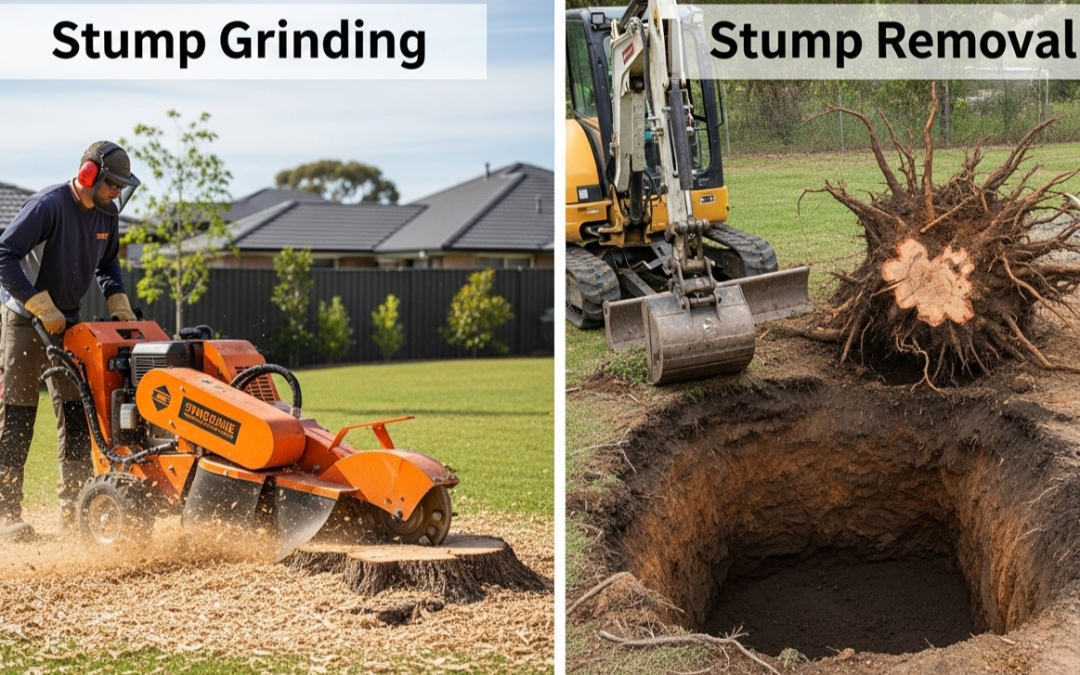When a tree is felled, what remains is the stump—and a decision must be made. Stumps are not only visually unappealing, but they can also draw in pests such as termites, pose a tripping risk, and disrupt landscaping efforts. The two main approaches to addressing a stump are grinding it down or completely removing it.
1. Stump Grinding: The Most Common Solution
Stump grinding is the most commonly requested service and is ideal for homeowners looking to reclaim their lawn area for planting grass, flowers, or small shrubs.
The Grinding Process
A professional stump grinder is a robust machine equipped with a large, rotating cutting wheel that has heavy-duty teeth. The operator methodically moves the wheel back and forth over the stump, breaking it down into small wood chips.
Typically, the machine grinds the stump to a depth of 6 to 12 inches below the surrounding soil level. This depth is generally adequate to cover the debris with topsoil, allowing for the establishment of a new lawn or garden bed without the stump causing any interference.
Benefits of Grinding
-
- Minimal Impact: The process is quick and significantly less disruptive to your existing landscape, resulting in a relatively small area of disturbed ground compared to complete removal.
- Cost-Effective: It demands less labor and time than full stump removal, making it the more economical choice.
- Ready-Made Mulch: The wood chips produced, often referred to as “grindings,” can be utilized as mulch in other parts of your garden or incorporated into the hole to decompose naturally.
2. Full Stump Removal: When You Need a Clean Slate
Complete stump removal entails the extraction of the entire stump along with all the major lateral roots associated with it. This procedure is labor-intensive and is typically reserved for particular circumstances where the area must be completely devoid of wood.
When Full Removal is Essential
-
- Construction & Paving: Should you intend to pour a concrete slab, set up a patio, construct a foundation, or pave a new driveway at the stump’s site, full removal is essential. Even deeply embedded roots can compromise the structural integrity of concrete over time.
- Immediate Replanting: If you plan to plant a new, sizable tree or any tree of the same species in the identical location, full removal is crucial to avert the risk of the old, decaying root material affecting the new tree.
- Serious Pest Problems: In exceptional instances of severe infestation (such as a significant termite colony residing within the root system), full removal may be advised to entirely eradicate the habitat.
Disadvantages of Full Removal
-
- Large Void: The complete extraction of the root ball results in a substantial, deep cavity that necessitates a considerable amount of fill dirt for leveling and often prolongs the stabilization of the area.
- Increased Cost & Time: This procedure is considerably more costly and demands a greater extent of heavy machinery and manual labor to remove the debris.
3. Why Professional Service is Essential
Stump work is not a task suited for DIY enthusiasts. Professional tree services utilize specialized equipment that guarantees both safety and efficiency:
-
- Robust Equipment: Rental grinders are frequently inadequate, being too small and weak to effectively manage large, dense Malaysian hardwood stumps. In contrast, professional grinders are of commercial-grade quality.
- Utility Awareness: Engaging in deep digging or grinding poses the risk of encountering buried utility lines (such as water, gas, and electricity). Professionals possess the training necessary to identify these lines prior to commencing work.
By having a professional evaluate your requirements, you can ensure that you receive the appropriate service—whether it be grinding for general aesthetic enhancement or complete removal for essential construction projects.
Conclusion
Deciding between stump grinding and complete removal ultimately hinges on your financial constraints and your future landscape intentions. Stump grinding is typically the quicker, more economical, and less disruptive approach, making it suitable for reclaiming lawn areas and planting new shrubs. In contrast, full stump removal is a thorough solution, necessary for significant construction endeavors, paving, or replanting a new tree in the same location.
Regardless of which choice is most suitable for your yard, both techniques necessitate specialized tools and expertise to prevent damage to utility lines and to guarantee a thorough and safe operation. Do not allow an old stump to attract pests or detract from your property’s visual appeal. Reach out to us today for a professional evaluation to identify the most effective and cost-efficient solution for your tree stump.

